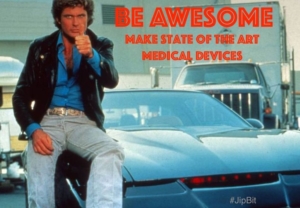I enjoy learning while teaching complex concepts, so I’m learning to improve my communications skills while writing a blog, using topics I enjoy as analogies to concepts in my work. If you’re reading this, please consider skipping it because it’s a work in progress and may not be worth your time.
Read more
Risk Control & Risk-Benefit
/in EU-MDR, Medical Devices, Risk Management /by jasonpartinThis article explains Risk / Benefit analysis and Risk Control methods using performances of Harry “The Hat” Anderson, a comedian, actor, and magician famous for visual humor.
Read more
Make state of the art medical devices
/in Design and Manufacturing, EU-MDR, Medical Devices, Risk Management /by jasonpartinThe new European Union Medical Device Regulation will protect patient safety by requiring healthcare companies to make products that are “state of the art,” a term that’s easily misunderstood. This law is best explained with an example from cars, comparing today’s state of the art with to the 1980’s television series Knight Rider, where David Hasselhoff fought crime in a talking, self-driving car.
Take this quiz to see if you’re ready for MDSAP
/in Medical Devices /by jasonpartinBy January 2019, the Canadian government will require all companies selling medical devices in Canada to be certified under the Medical Device Single Audit Program (MDSAP). If you’re familiar with MDSAP, this article quizzes your knowledge of key concepts. If it’s new to you, read how to prepare for MDSAP.
Read more
Van Halen, Brown M&Ms, and Quality Assurance
/in Design and Manufacturing, EU-MDR, Medical Devices, Risk Management /by jasonpartinIn the 1980’s, the rock-band Van Halen caused $85,000 damage to their dressing room after finding brown M&M’s in their bowl of “munchies” before a concert. The facts behind that story can help medical-device companies become more efficient and pass any FDA or ISO Quality-System audit. This article shows you how, with the lead singer of Van Halen, David Lee Roth, as your guide.
Read more
Reduce Risk As Far As Possible
/in EU-MDR, Medical Devices, Risk Management /by jasonpartinRead more
How to apply Risk Management
/in EU-MDR, Medical Devices, Risk Management /by jasonpartinIn 1986 the space shuttle Challenger exploded, killing the crew and a high-school teacher that had trained with the astronauts. In this article, I travel back in time to reanalyze the Space Shuttle program using modern methods for Risk Management.
The MDR big picture
/in EU-MDR, Medical Devices /by jasonpartin7 minute read.
Any company that wants to sell medical devices in the European Union must follow new EU Medical Device Regulations. These new regulations were motivated by EU citizens demanding safer healthcare. This article is the EU-MDR big picture with links to learn more. Read more
Time is valuable; write concisely.
/in Uncategorized /by jasonpartinRead more
The risk of being biased
/in EU-MDR, Medical Devices, Meditation, Risk Management /by jasonpartinRead more
Why I practice writing
/in Meditation /by jasonpartinI enjoy learning while teaching complex concepts, so I’m learning to improve my communications skills while writing a blog, using topics I enjoy as analogies to concepts in my work. If you’re reading this, please consider skipping it because it’s a work in progress and may not be worth your time.
Read more